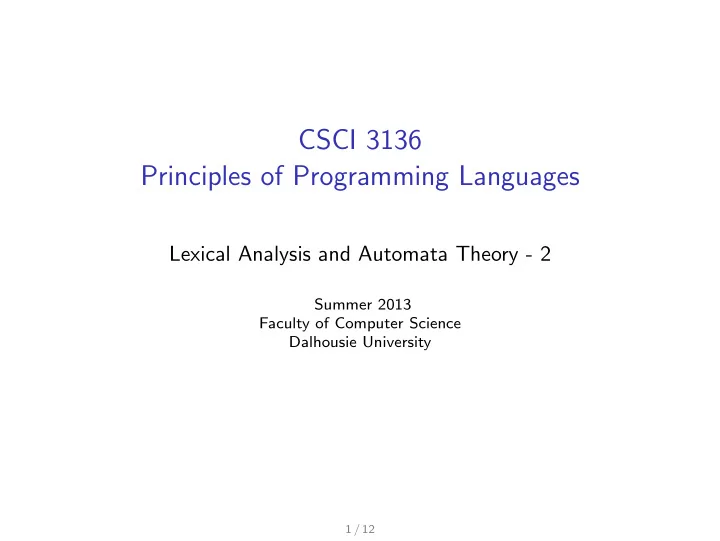

CSCI 3136 Principles of Programming Languages Lexical Analysis and Automata Theory - 2 Summer 2013 Faculty of Computer Science Dalhousie University 1 / 12
Class Location Change for two days in July Lecture class on Monday July 15 and Wed. July 17 would be at Room 226, Chemistry building. 2 / 12
Scanner Parser (DFA) (PDA) recognizes recognizes Regular Expression Context-free Grammar are gen- are gen- erated erated by by Regular Language Context-free Language
Scanner Implementation Also known as RegEx = ⇒ Scanner (DFA) • RegEx = ⇒ NFA (nondeterministic finite automaton) • NFA = ⇒ DFA (deterministic finite automaton) • Minimizing the DFA 4 / 12
Deterministic Finite Automata (DFA) A deterministic finite automaton (DFA) is a simple machine that accepts or rejects a given input string. This defines a formal language: the set of strings accepted by the DFA. We say the DFA recognizes this language. A language is regular if and only if there exists a DFA that recognizes this language. 5 / 12
Example of a DFA 1 0 1 q 1 q 2 start 0 Informal definition of a DFA Transition Function • Finite set of states • Designated start state 0 1 • Designated set of final states → q 1 q 1 q 2 • Reads input one symbol at a time. � q 2 q 1 q 2 New state is calculated as a function of current state and read symbol. • String is accepted if and only if a final state is reached after reading the entire string. 6 / 12
Example of a DFA 1 0 1 q 1 q 2 start 0 Which language does this DFA recognize? 7 / 12
Formal Definition of a DFA 0 1 1 q 0 q 1 start 0 A DFA is a 5-tuple ( Q , Σ , δ, q 0 , F ) 0 1 • Q is a finite set of states → q 0 q 0 q 1 • Σ is a finite set of input symbols (i.e., q 1 � q 0 q 1 an alphabet ) • δ : Q × Σ → Q is a transition function • q 0 ∈ Q is the start state • F ⊆ Q is the set of final or accepting states The DFA accepts a string σ ∈ Σ ∗ if and only if it reaches a final state after consuming all letters in σ . The language recognized by a DFA D is the set of strings L ( D ) := { σ ∈ Σ ∗ | D accepts σ } . 8 / 12
Non-Deterministic Finite Automata (NFA) A DFA is deterministic in the sense that every input traces exactly one path through the automaton. A non-deterministic finite automaton (NFA) is identical to a DFA, except that there are possibly many paths traced by an input. Two sources of non-determinism • ǫ -transitions ǫ q 1 q 2 start • Multiple successor states for the same input symbol q 2 1 1 q 1 q 3 start An NFA accepts a string σ ∈ Σ ∗ if one of the paths traced by σ ends in an accepting state. 9 / 12
Example of an NFA 0/1 0/1 0/ ǫ 1 q 1 q 2 q 3 start Transition Function 0 1 ǫ → q 1 { q 1 } { q 1 , q 2 } – q 2 { q 3 } – { q 3 } q 3 � { q 3 } { q 3 } – Which language does this NFA recognize? 10 / 12
Formal Definition of an NFA An NFA is a 5-tuple ( Q , Σ , δ, q 0 , F ) • Q is a finite set of states • Σ is a finite set of input symbols (i.e., an alphabet ) • δ : Q × (Σ ∪ { ǫ } ) → 2 Q is a transition function • q 0 ∈ Q is the start state • F ⊆ Q is the set of final or accepting states Every input σ ∈ Σ ∗ defines a set of paths traced by δ while consuming σ . The NFA accepts a string σ if and only if one such path defined by σ ends in a final states. The language recognized by an NFA D is the set of strings L ( D ) := { σ ∈ Σ ∗ | D accepts σ } . 11 / 12
12 / 12
Recommend
More recommend